Uro-oncology
Uro-oncology
Uro Oncology is a field applied to the diagnosis and treatments of tumors of urinary operations. Most likely taking care of patients with prostate cancer, kidney, testicular and bladder cancer. Physicians that are trained in this field are called Uro–oncologists. An Uro-oncologist doctor who handles cancer and provides medical care for a person diagnosed with cancer. The field of oncology has three major areas: medical, surgical, and radiation. A medical oncologist treats cancer using chemotherapy or other medications, such as targeted therapy or immunotherapy.

Dr. Anurag Gupta is one of the Best Uro-oncologist Doctor is proficient in treating the patient, who is suffering from harmless and malignant diseases of urinary bladder, prostate, Kidney, and other genitourinary organs.He is a specialised in this field who is expert to provide total diagnosis and treatment of genitourinary cancer with a very good experience, a professional in minimally invasive surgeries.
Uro-oncologist doctor believes in a multimodality treatment strategy providing the most effective treatment and best real outcome directed towards the excellent quality of life.
This field is dedicated to the diagnosis and treatment of tumours of urinary systems. Most importantly taking care of patients with prostate cancer, kidney, testicular and bladder cancer. If you are facing the pain and symptoms related to urinary diseases then visit at Dr. Anurag Gupta Urology Clinic
Urologic Oncology Overview
Thousands of men and women are diagnosed each year with cancer of the prostate, bladder or kidney, as well as testicular cancer. New breakthroughs in cancer care, experimental treatment options, and ongoing research into the causes and potential cures of urologic malignancies spell new hope for patients from all walks of life.
Conditions
- Bladder Cancer
- Prostate Cancer
- Kidney Cancer
- Testicular Cancer
Treatment of Bladder Cancer
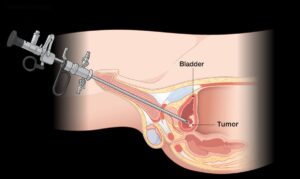
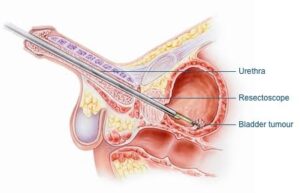
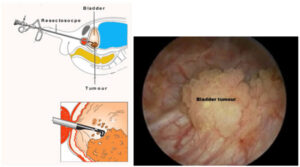
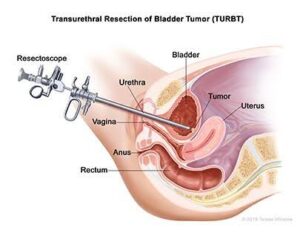
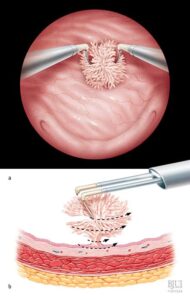
Trans urethral removal of bladder tumour (TURBT)
A trans urethral resection of bladder tumour (TURBT) is usually the first treatment you have for early bladder cancer.
Your surgeon removes the tumour in your bladder through the urethra. The urethra is the tube that carries urine from the bladder to the outside of your body.
You might have TURBT to remove early bladder cancer:
- during a cystoscopy test if your specialist sees a tumour
- after having tests that have shown a bladder tumour
- You usually have it under general anaesthetic, which means you are asleep. In some hospitals, you may have a spinal anaesthetic instead of a general anaesthetic. This is an injection into your spine (epidural) so you can’t feel anything from below your waist.
- This treatment takes between 15 to 90 minutes.
How you have it
The surgeon puts a thin rigid tube called a cystoscope into your urethra.
The cystoscope has optic fibres inside it, a light, camera and eyepiece at one end. The surgeon can look through the eyepiece or see images on a TV screen.
The surgeon passes small instruments down the cystoscope to cut any tumours out of your bladder lining.
What happens
You usually have this at the hospital in the day surgery unit. You might go home on the same day of your operation. But sometimes you have to stay in overnight or for a couple of days.
Before the operation
- A nurse usually sees you in pre-assessment clinic a week or two before surgery.
- They’ll take some measurements (weight, temperature, heart and breathing rate, oxygen levels and your blood pressure).
- You might have a blood test, chest x-ray and ECG. This is normal for anyone having a general anaesthetic.
- The nurse gives you instructions about the operation and what to bring on the day. It’s a good idea to bring an overnight bag. They’ll also tell you when to stop eating or drinking.
- For a general anaesthetic, you usually have to stop eating at least 6 hours beforehand. And you can drink sips of water up to 2 hours before.
When you arrive
On the day of your operation you’ll see the surgeon who will explain the procedure and ask you to sign a consent form. This is a good time to ask any questions.
You’ll also meet your anaesthetist who will get you to sleep and look after you while you’re asleep.
The nurse gives you a hospital gown to change into. So you need to remove all your clothing.
The nurse and porter take you to the anaesthetic room on a theatre trolley.
You usually have a small tube put into your vein (cannula) before you have the anaesthetic. This is so they can give you medicines directly into your vein. Most hospitals also give you an injection of antibiotics before the procedure.
The operation
Once you are asleep or the spinal anaesthetic is working your surgeon passes the cystoscope into your urethra.
They use the cystoscope to look at the inside of your bladder. They also pass small instruments down the cystoscope. They use these instruments to remove any tumours. They then use a probe to seal (cauterise) the area to stop any bleeding.
Picking up bladder cancer
Surgeons might be using another method as well to help spot bladder cancer. These are not available in all centres. Your surgeon will explain what they will be using in your TURBT operation.
Narrow band imaging
Your surgeon uses different colour lights (blue and green) to get a better look and understanding of your bladder. These lights can reach deeper tissue layers in the bladder and can help show up abnormal areas.
Photodynamic diagnosis (PDD)
Your surgeon may put a dye into your bladder an hour before you have your TURBT. The dye is sensitive to light. During the surgery they shine a blue light on the bladder lining. This is called photodynamic diagnosis (PDD). It can help to show up areas of cancer more clearly.
Chemotherapy
Usually you have a dose of chemotherapy into the bladder at the end of your operation. Or you may have it when you return to the ward. You have it within 6 hours of having the operation.
This is to help stop the bladder cancer from coming back and get rid of any cancer cells that may have been left behind.
After surgery
- You go to a recovery area to rest after an anaesthetic. Your nurse monitors you and takes regular measurements until you wake up from the anaesthetic properly.
- You can eat and drink normally.
- You may have a tube into your bladder (catheter) to drain urine into a bag for a short time. The nurse removes it before you go home.
- You may see blood in your urine. This might last for up to 3 days. This won’t mean you can’t go home.
- You may notice some bleeding 10 to 14 days after the operation. Do not worry about this it can be normal. Drink plenty but if it doesn’t stop within 24 hours call your advice line.
- Your doctor asks you to drink lots of fluids, to flush out your bladder. This helps to protect you from getting a urine infection.
- When you first start passing urine it may burn and sting for several days. You’ll be given painkillers to help make this more comfortable.
- If you’re having a general anaesthetic you’ll need someone with you so they can take you home and stay with you overnight. Also for 24 hours after you shouldn’t drive, drink alcohol, operate heavy machinery or sign any legally binding documents.
Possible risks
A TURBT is a safe procedure. Your nurse will tell you who to contact if you have any problems after your TURBT. Your doctors will make sure the benefits of having a TURBT outweigh any possible risks.
- Some possible risks include:
- Bleeding
- You should contact the hospital immediately if:
- the bleeding is getting worse
- there are blood clots in your urine
- you have severe pain when passing urine
- you can’t pass urine and have severe pain
- Infection
- There is a risk of infection. Symptoms can include:
- going to the toilet more often
- burning and stinging when passing urine
- high temperature
- feeling hot and cold or shivery
- cloudy or offensive smelling urine
- generally feeling unwell
- Contact your doctor as you might need antibiotics to treat an infection.
- Damage or injury to the bladder
Rarely, there can be a small tear (perforation) of the bladder or it may be injured. It’s likely this will settle with a catheter for a few days to rest the bladder. Very rarely you may need surgery to help fix this problem.
Bruising and swelling
You might get a small bruise around the area where they put the needle in for the cannula.
There’s is a risk that the anaesthetic or antibiotics will leak outside the vein. This can cause swelling and pain in your arm but it’s rare.
All Department
- Laparoscopic Urosurgeon
- Urinary / Kidney Stone Treatment
- Laser Treatment for Kidney Stone
- Uro-Oncology
- Surgery for Prostate
- Urinary Cancer
- Ureteric Stricture
- Urethral Stricture
- Male Infertility
- Prostate Surgery
- Erectile Dysfunction
- Prostate Cancer
- Female Urinary Incontinence
- Interstitial Cystitis
- Overactive Bladder
- Vesicovaginal Fistula
- PCNL
- Ureteroscopy
